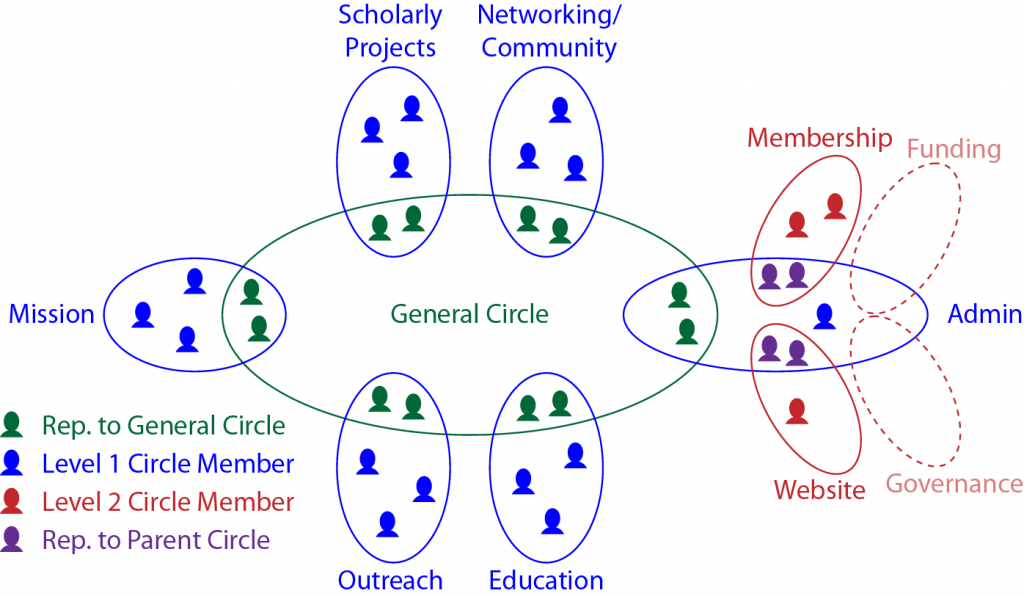Origins
PLAN was initiated by Ben McCall (chemistry background), Melody LeHew (fashion studies), Tom Love (anthropology), David Murphy (environmental studies), and Tom Murphy (physics). These five co-authored a PLAN “launch” paper called Modernity is incompatible with planetary limits: Developing a PLAN for the future. See the page on PLAN Founders for more information.
Governance
In early 2022, PLAN became a sociocracy, which is a form of distributed governance de-emphasizing hierarchy and central control. Some PLAN members have joined “circles” (like committees) to move PLAN forward on a number of parallel fronts.

The figure above indicates how this works. Each circle has overlap to its parent circle, consisting of two representatives (circle leader and delegate). We can think of the Mission Circle as the head: setting the overall course and values of the network. Four “legs” move the organization forward on parallel fronts. An administrative “business-end” handles logistics. The General Circle (torso) facilitates the flow of information between the circles and “decides who decides” issues or initiatives, preventing duplication of efforts (but not a centralized authority: circles have the authority to make and implement decisions).
Another key feature of sociocracy is that decisions are made by consent (not the same as consensus). A decision might not be the preferred outcome of all circle members, but it is deemed not to violate the aim of the circle, and is within the range of tolerance.
Circle Aims
The aims of the circles provide guidance on direction and decisions, and are as follows:
- Overall PLAN Aim: PLAN aims to foster collaboration, community, outreach/education efforts among scholars around the topic of planetary limits, in keeping with the network’s foundational principles.
- Mission: Preserve, evolve, and provide strategic guidance in advancing PLAN’s mission and aims.
- Scholarly Projects: Facilitate scholarly efforts to advance understanding of the challenges of living within planetary limits, to map the landscape of feasible responses for addressing these challenges, and to discern pathways for appropriate systemic changes.
- Networking/Communication: Actively promote contact between Members/Collaborators, including informal meeting mechanisms and effective ways to find each other and connect.
- Outreach: Construct external communications for academic and general audiences, engaging in media relations, op-eds, podcasts, blogs, videos, public talks. External Web Content: maintain content on the PLAN website that is visible externally (resources, articles); Media Relations: serve as point of contact with media, act as spokespeople, place PLAN-related content in various media outlets.
- Education: Work to develop materials that can be shared in classrooms at all levels, including an “on-boarding” path for new members to become more fully aware of the interconnected systemic components guiding civilization and its challenges.
- Administration: Facilitate the other circles in accomplishing their tasks by providing tools and guidance, and overseeing the recruiting and vetting of members.
- Membership: Vet applicants, maintain and apply the codes of conduct, recruit new members, and maintain updated statistics on PLAN composition.
- Website: Maintain and develop the website to provide value to members in terms of functionality and content.
- Governance: dissolved itself after sociocratic implementation was self-sustaining.
- Funding: not yet established
A circle can consent to an update of their aim, which is then passed to the parent circle for approval.
Roles within Circles
Each circle has four designated roles:
- Leader: responsible for the vision of the circle, in the context of the organization as a whole. The leader ensures that promised tasks get done. The leader is automatically a member of the parent circle as one of two links, and as such communicates organization needs to the circle. We might associate the leader with “future.”
- Secretary: keeps and makes available records of circle meetings and decisions. The secretary also tracks what needs to be on meeting agendas, particularly remembering when a policy needs to be reviewed or that it is time for a new selection process for a role whose term of office is ending. We might associate the secretary with “past.”
- Facilitator: conducts the meetings themselves, first preparing the agenda in consultation with the leader and secretary, then guiding the circle through all the steps of decision-making. We might associate the facilitator with “present.”
- Delegate: is the second link to the parent circle, noting what needs to be communicated “up.” The delegate participates as a full member in both circles. The delegate will report from their circle and make sure issues or concerns from their circle will be heard.
